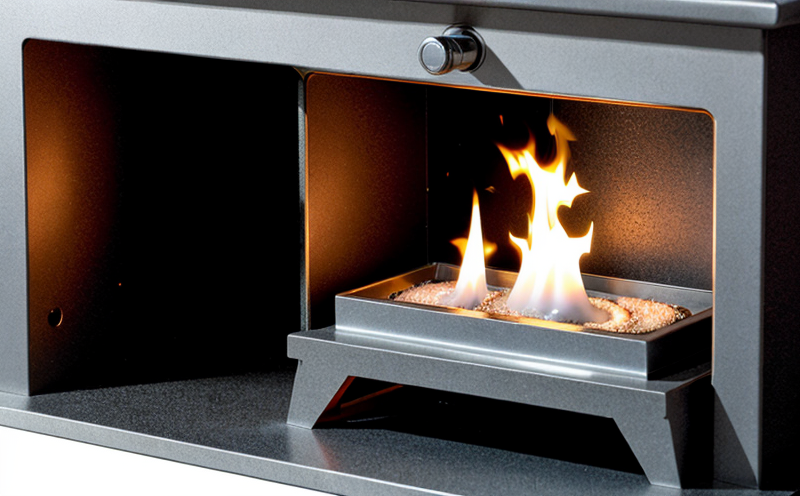Reaction-to-Fire Testing of Wall Cladding Materials
The reaction-to-fire testing of wall cladding materials is a critical aspect of ensuring fire safety in construction. This service evaluates how wall claddings behave when exposed to flame, providing insight into their ignition properties and resistance to spread of fire.
Wall cladding systems are an integral part of building envelopes, serving both aesthetic and functional purposes. However, the materials used for cladding can significantly affect a building’s fire performance. Reaction-to-fire testing is essential in selecting appropriate wall claddings that comply with local and international standards, ensuring buildings meet safety regulations.
The testing process typically involves exposing small specimens of the wall cladding to controlled flame sources under specific conditions. The apparatus used includes devices such as the Cone Calorimeter or Steady Flame Test Apparatus (SFPA). These tests measure several parameters including heat release rate, smoke production rate, and the time it takes for a flame to spread along the specimen.
Understanding these properties is crucial because they directly influence fire safety. For instance, a material with high heat release rates and rapid flame spread can contribute significantly to the severity of a fire in a building. Conversely, materials that resist ignition and slow down the spread of flames are preferred for their enhanced fire safety performance.
The testing process also helps in assessing the ignitability of wall cladding materials under specific conditions. This includes determining whether the material will ignite when exposed to a flame source and how quickly it does so. The results can guide manufacturers in selecting appropriate base materials, additives, or coatings that improve the fire performance of their products.
Compliance with relevant standards such as ASTM E84-21, ISO 6703:2009, and EN 13501-1 is essential. These standards provide a framework for testing procedures and acceptance criteria, ensuring consistency in the evaluation of fire performance across different materials.
Real-world applications of this service include:
- Evaluating new wall cladding designs before market release
- Compliance with building codes and regulations
- Improving product safety for end users
- Potential cost savings by identifying materials that do not require additional fire retardants
- Enhancing the reputation of manufacturers through adherence to stringent testing protocols
The importance of this service cannot be overstated, given the potential risks associated with poor-quality wall cladding. By understanding and addressing the fire performance characteristics of these materials, we can contribute significantly to public safety.
Scope and Methodology
The scope of reaction-to-fire testing for wall cladding materials encompasses a range of procedures aimed at assessing their ignition properties and flame spread behavior. This service typically involves the following steps:
- Selecting appropriate specimens from the wall cladding material.
- Preparing the specimens according to specified dimensions and weight requirements.
- Exposing the specimens to controlled flame sources under specific conditions in a testing chamber.
- Monitoring critical parameters such as heat release rate, smoke production rate, and time to ignition.
- Recording data from each test run for comprehensive analysis.
- Comparing results against accepted standards and criteria.
The methodology employed is designed to simulate real-world conditions while providing precise measurements of the material's reaction to fire. This includes using controlled environments that mimic various ignition scenarios, ensuring reliability and accuracy in testing outcomes.
For instance, the Cone Calorimeter test simulates a situation where a small flame source approaches the wall cladding material. The apparatus measures how quickly the material ignites, how much heat it releases, and how much smoke it produces during combustion. Similarly, the Steady Flame Test Apparatus (SFPA) assesses the resistance to spread of flame along the surface of the specimen.
These tests are crucial in identifying materials that meet stringent fire safety standards. By adhering to these protocols, we ensure that wall cladding materials perform reliably under fire conditions, thereby enhancing building safety and compliance with regulatory requirements.
Industry Applications
| Application | Description |
|---|---|
| Evaluating new wall cladding designs before market release | This ensures that the materials used are safe and comply with fire safety regulations. |
| Compliance with building codes and regulations | This helps in avoiding legal issues and ensuring public safety. |
| Improving product safety for end users | This enhances trust among consumers who use buildings containing these materials. |
| Potential cost savings by identifying materials that do not require additional fire retardants | This reduces production costs while maintaining high fire performance standards. |
| Enhancing the reputation of manufacturers through adherence to stringent testing protocols | This boosts brand image and market credibility. |
| Evaluating existing wall cladding systems in older buildings for retrofitting | This ensures that older buildings meet modern fire safety standards. |
| Research and development of new fire-retardant coatings or additives | This aids in the continuous improvement of building materials. |
The application of reaction-to-fire testing is broad, spanning various sectors including residential, commercial, and industrial buildings. This service plays a pivotal role in ensuring that wall cladding materials contribute positively to fire safety without compromising other essential properties like durability or aesthetics.
Competitive Advantage and Market Impact
- Pioneering the use of advanced testing techniques that exceed basic compliance requirements.
- Offering customized testing solutions tailored to specific client needs, enhancing market relevance.
- Providing detailed insights into fire performance characteristics, aiding in strategic product development.
- Ensuring products meet or exceed international standards, increasing global market access.
- Building long-term relationships with clients through reliable and consistent service delivery.
- Staying ahead of regulatory changes to ensure compliance without compromising quality.
- Offering training and education on fire safety testing methodologies to industry professionals.
The impact of this service is profound, not only in terms of immediate benefits but also in fostering a culture of continuous improvement within the construction industry. By leveraging advanced testing techniques and adhering strictly to international standards, we help clients achieve competitive advantages that translate into enhanced market positions.





